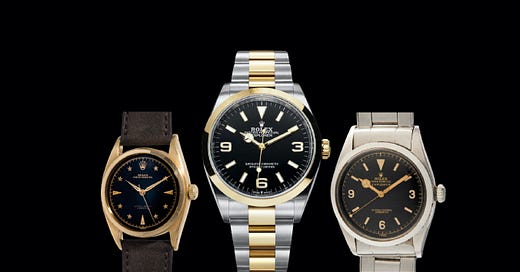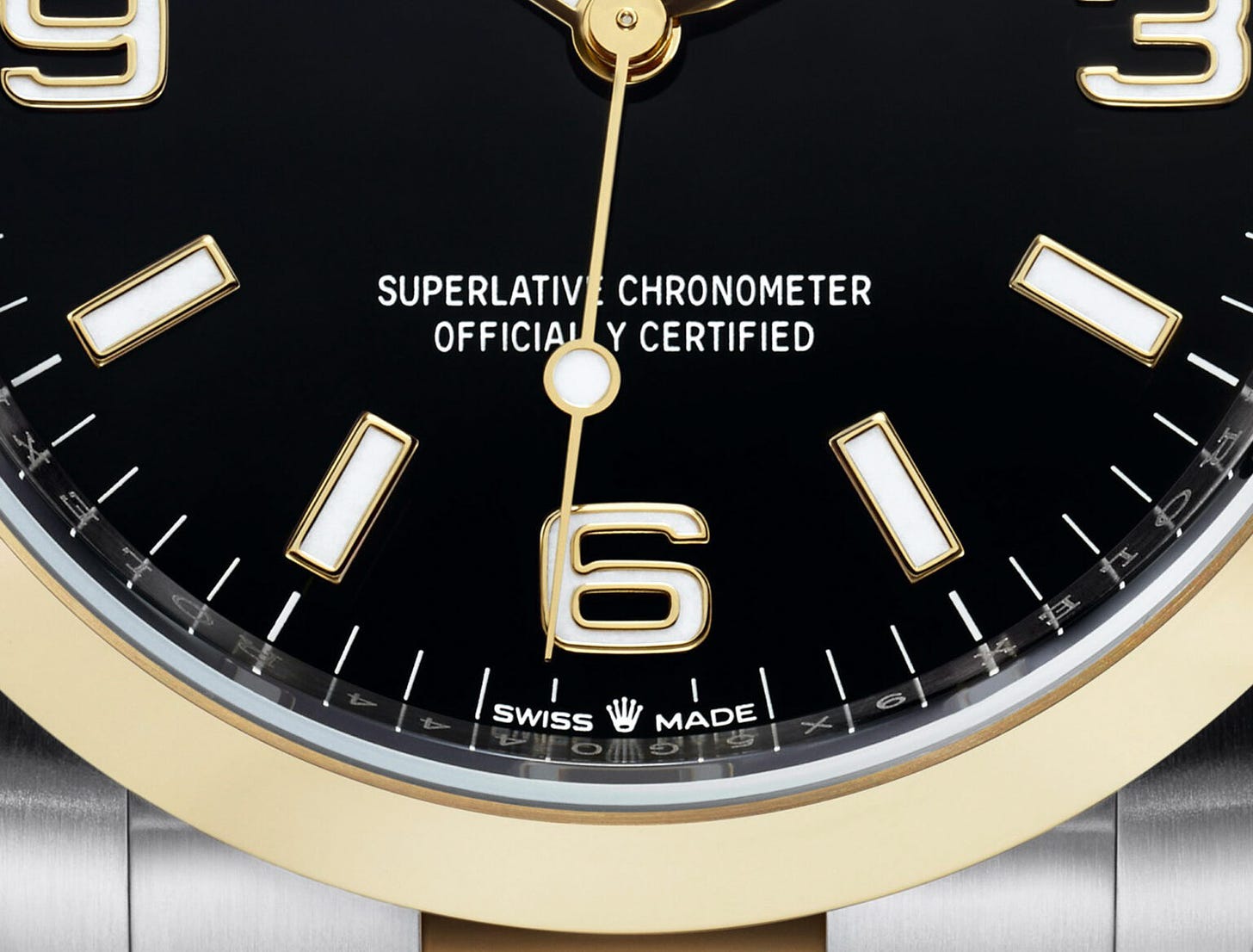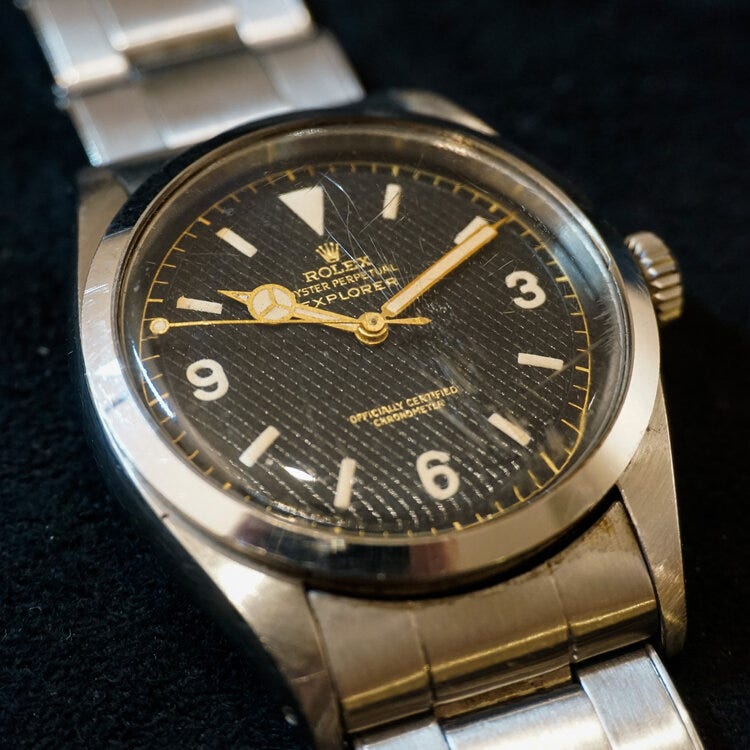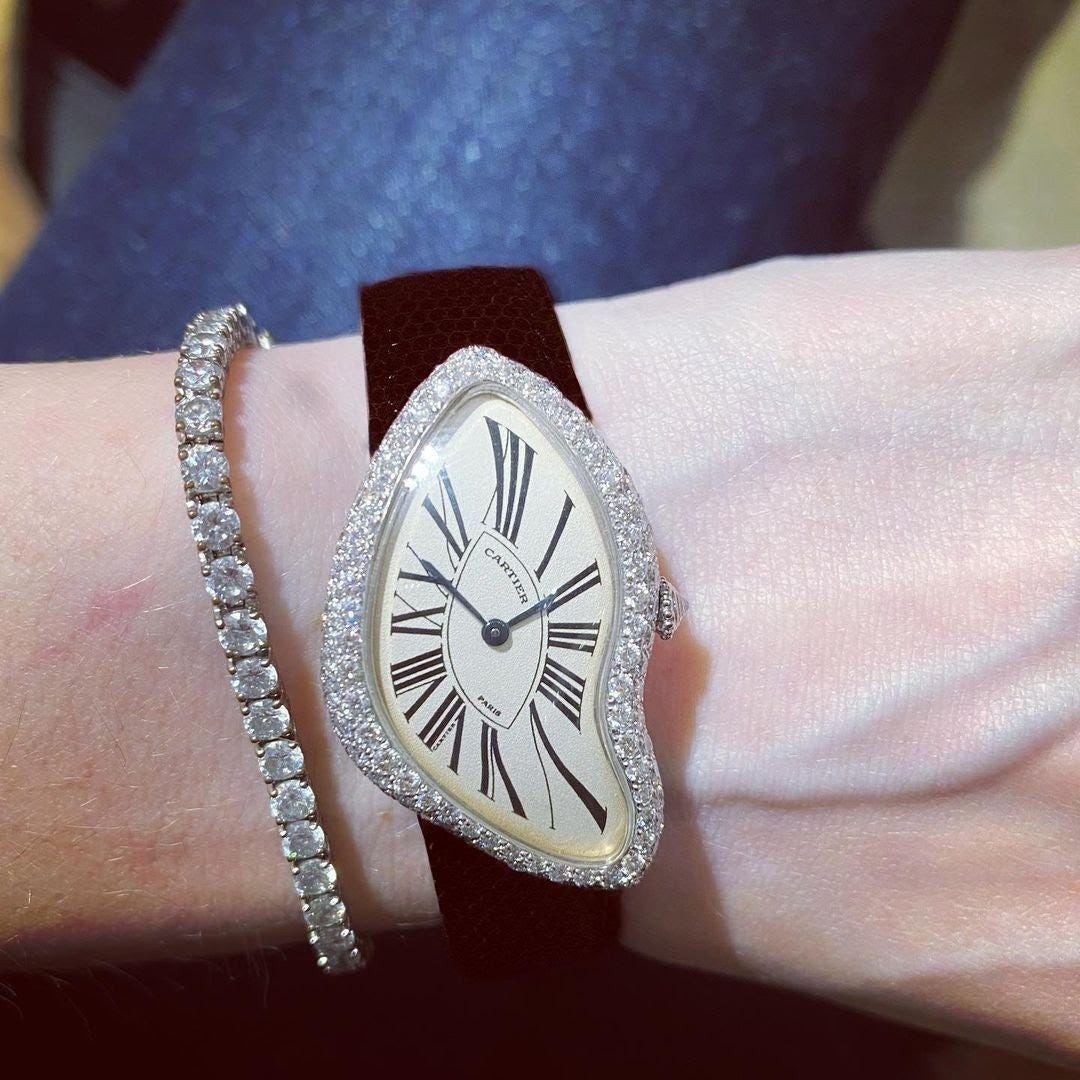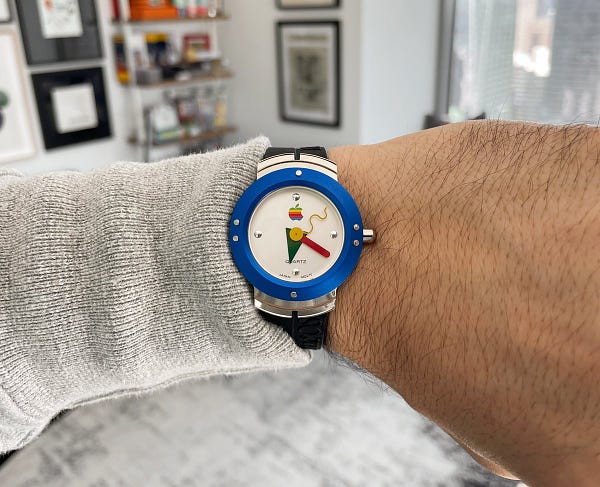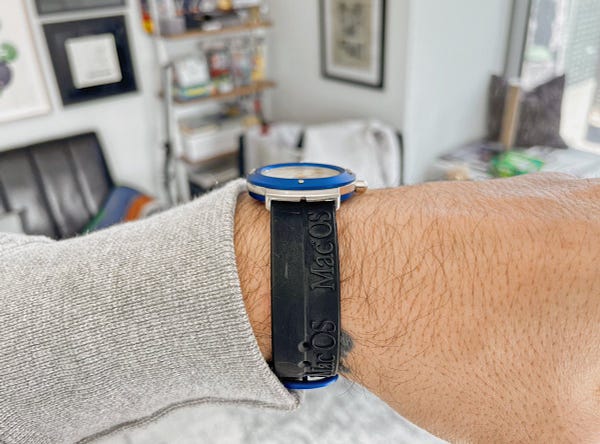Rolex and the return of 'sports elegance'
Is elegance (and two-tone) the answer to our identity crisis?
In our collector profile this week (see below), young collector J.J. Owens mentions that her favorite era of watches is Rolex in the 1950s.
“From the ref. 6542 [the first GMT-Master] to the 6062 [the triple calendar moonphase in an Oyster case], if you look at the range and capability of what they were able to do, it’s just phenomenal,” she says.
I’d been wanting to write about this era of Rolex because it’s long been the most enchanting to me too. Luckily, a few things came together to make it more relevant than ever.
Recently, collector Edmond Saran, on his blog Le Monde Edmond, did a three-part series (1, 2, 3) on the 1940s-50s era of Rolex, what he terms “sports elegance.” During this era, Rolex was the only brand that could deliver a versatile sports watch with a robust waterproof Oyster case and perpetual automatic movement, but in elegant precious metals and dial variations.
Then, at Watches & Wonders Rolex dropped the two-tone Explorer and a lot of people came in with the “a sports watch has to be stainless steel!” take, failing to look back to the 40s-50s era of sports elegance when, well, Rolex made two-tone sports watches (or straight-up precious metal sports watches) all the time.
To me, the two-tone Explorer is a clear callback to Rolex’s era of 1940s-50s sports elegance. So often, we hear how Patek Philippe dreads being associated with one watch, and one watch only, that stainless steel time-only one that trades at 3x its retail price. That really, Patek would love to get back to the very serious business of producing complicated watches in precious metals, and please stop asking about the Nautilus, okay?
Have we ever really stopped to think that Rolex might feel the same way? To be sure, Rolex is a different beast than Patek, but don’t you think sometimes Rolex looks itself in its rainbow-bezeled mirror at night and says to itself, “I’m so much more than stainless steel sports watches, I just wish everyone else could see it!”
Much the way collecting more broadly seems to be having a sort of identity crisis where everything centers around stainless steel and sports, the big brands are having this same crisis.
The two-tone Explorer feels like a small reaction against that internal conflict. Injecting a little bit of elegance back into a brand that feels mostly removed from its sports elegance of a bygone era.
Oyster Perpetual Elegance
As Saran writes, the sports elegance era is:
“Rolex at its height of artistic capabilities. In my view, it beat its competitors like Vacheron and Patek (not to mention AP, Breguet, Longines, Eterna or any other high end manufacturer of that time).”
In his series, Saran focuses on star, enamel, and black lacquer dials. The Bao Dai 6062 is perhaps the watch most emblematic watch of the era. But the logic extends much further. In addition to these truly artistic creations, Rolex was, as J.J. mentions, dropping complicated movements into Oyster cases, and oh-by-the-way, simultaneously laying the foundation for the next generation of stainless steel sports watches with the first GMT-Master, Submariner, etc. — those watches that are the focus of today’s collectors, too often overlooking this era just before.
Nowadays, we take for granted that pretty much every Rolex dial has a couple words, Oyster Perpetual, printed on it.
But back in the 40s and early 50s, these two words were its entire point of differentiation. Brands were still catching up with Rolex’s waterproof Oyster case and crown (1926 patent), and its patent on the perpetual rotor (1931) prohibited others from producing competing watches.
Not until Patek released the venerable ref. 2526 in 1953 did Rolex start to get some real competition on both vectors. A certain writer for a certain more successful publication used this as partial proof for why the Patek 2526 is “a watch to pay attention to” all those years ago. It’s a valid point, but it’s also a reminder that Rolex had a literal two-decade head start when it came to perpetual rotor calibers and waterproof cases. And in some of these watches from the 40s-50s, it’s clear they took full advantage of it.
An era to pay attention to
So while Patek was just getting started in 1953, Rolex’s sports elegance efforts were in full swing. Let’s quickly look at just two watches from that year to illustrate the breadth of its efforts.

Some of the most desirable models from the era feature rare “Stelline”-style dials with star-shaped hour markers. Even better are examples featuring black galvanic dials, like this yellow gold example that sold at Phillips for CHF425k in 2015.
It’s basically an ovettone, or big Bubbleback, with its 36mm Oyster case, but with a crazy special dial. Like, imagine putting all this work into manufacturing the most robust waterproof case in the world (and dumping tons of marketing dollars into telling everyone about it), and then putting this totally beautiful, elegant, black dial with stars on it.
It makes no sense. And that’s why it’s so beautiful.
While the star dial skews more towards the elegant side of the sports elegance spectrum, this Explorer ref. 6350, illustrates the sportier side. It shares the same movement with the star dial, but pretty much everything else is different.
Stainless steel case, honeycomb dial, early Explorer 3-6-9 layout. This is Rolex setting the foundation for its next 70 years of sports watches. This one came from the original owner, an octopus wrestler, and sold for $126k at Phillips last December. “The dial blew me away in person,” our correspondent wrote at the time.
While Patek may have made a single watch worth paying attention to in 1953, these two watches start to show why 1940s-50s Rolex sports elegance is an entire era to pay attention to.
If some of Rolex’s recent releases — like that two-tone Explorer — are Rolex reclaiming a bit of its elegance from this era of sports elegance, perhaps there’s not such an identity crisis after all.
👉 Enjoying this very elegant and sporty newsletter? Please subscribe to support independent writing and get it delivered to your inbox once a week:
Collector Profile: J.J. Owens
This week, we also published a profile of J.J. Owens, a young collector from New York.
By: Charlie Dunne
In our conversation, we covered a lot of ground: her favorite New York retailers, bouncing ideas back and forth on how watch collectors can foster a more welcoming atmosphere, and our shared admiration for Ryan Gosling (and his Rolex Bubbleback) in Crazy, Stupid, Love.
For J.J., watches are just a small part of the bigger picture. Her introduction to watches stems from her relationship with her father. At 13, he gave her a manual wind Cartier Tank. J.J. is very cognizant of how fortunate she is to have such a strong relationship with her father and continued to emphasize this while we discussed our relationships with our fathers. She would go on to tell me how this Cartier accompanied her throughout her teenage years and would remain on her wrist even during tennis practice.
“In hindsight, this would be a cardinal sin for watch collectors, but to be fair this is the way watches were meant to be worn!”
C.D.: Do you mind telling me about your first watch?
J.J.: My father was very adamant that my first watch was not going to be a new watch, but rather a vintage watch. So I really learned the intricacy behind a mechanical watch and how delicate the movement was.
I got the [Cartier] Tank and it never left my wrist. I wore it for tennis, skiing... I wore it everywhere you could imagine. I loved that watch and loved the responsibility of winding it every morning. It made me that much closer to the piece.
I don’t think I realized how historically significant that watch was until around 3-4 years into wearing it. When you first get a watch, if you’re not necessarily that into watches, you don’t realize what people are wearing. The watch-spotting comes later.
I still have that watch, and I save it for special occasions. I brought it into Cartier once, and the salesperson mentioned that the sapphire crown was in such good condition. That’s because I wear my watch on my right wrist and most people will bang the crown against something.
👉 Read the full profile of J.J.
Through the Wire
A Buzzy Enicar Sherpa Graph. At Bukowski’s Timepieces auction this week, perhaps the most exciting action was on this Enicar Sherpa Graph Mark 1a, which ended up selling for ~$16k, around 2x its estimate. Friend of the ‘sletter Nico did a great write-up on Enicar 101 about the Mark 1a before the auction, explaining that only about 28 examples have been found. In other words, it’s a rare watch worthy of the buzz it generated up in Sweden this week.
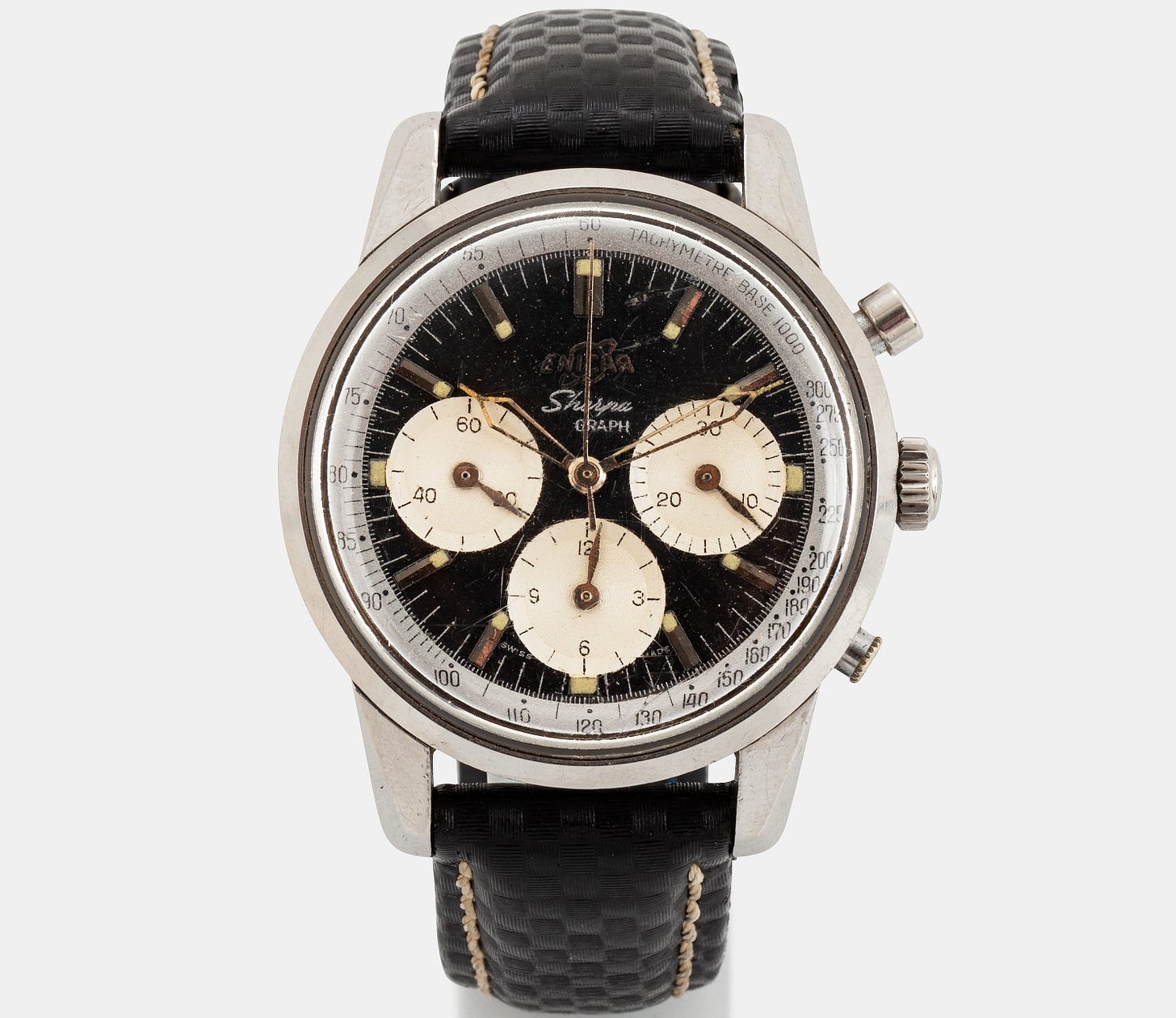
Sign Here, Please. Speaking of auctions. There are so many to sift through over the next few weeks, but all I can think about is this platinum Cartier fountain pen watch at Sotheby’s Hong Kong. I’ve been on a real horological objects bender lately (searching for the perfect watch money clip, thanks for asking), and Cartier has some of the most elegant *objets d'art*.
Going Off on Off-White. As long-time subs know, I “love” (get it?) Virgil Abloh. So I ate up the New York Times graphic essay “Inside Virgil Abloh’s trademark ballet” that analyzes 1000s of lawsuits, trademark filings, and more from Abloh and his Off-White fashion empire.
Rescapement is an independent weekly newsletter about watches, mostly vintage. Subscribe now to get it delivered to your inbox every Sunday. Follow us on IG too.
Tweet of the week:
Maybe I’m into the Apple Watch after all (h/t Clayton)…


